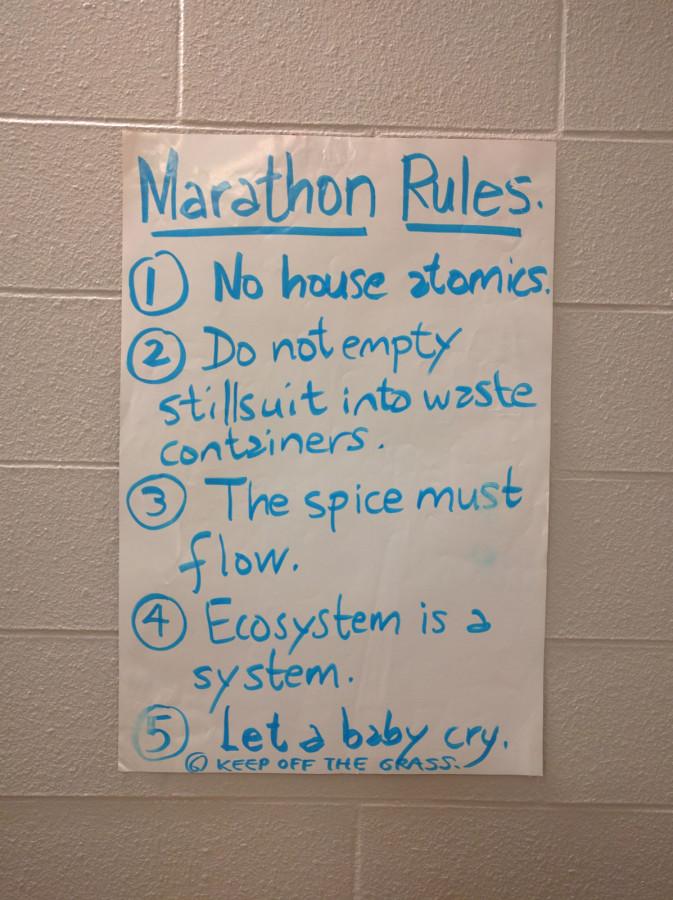Sci-Fi and Community: Annual film society marathon connects fans
Sarah Kim and Ellie Rambo/Observer
Strosacker Auditorium was decorated with movie posters and playful rules for the Sci-Fi Marathon.
The movie industry has always had a fascination with science fiction, tracing its roots back to the late 1920s with “Metropolis” (1927) and “Frankenstein” (1931). But relatively recent films, like “Star Wars,” “Jurassic Park” and “The Matrix” hooked many modern viewers and catapulted the genre into the stratosphere.
For their 41st year, the Case Western Reserve University Film Society celebrated this legacy with a Science Fiction Marathon last weekend. The two-day marathon celebrated everything from cult favorites to some of the biggest films in recent years.
The Marathon traces its roots back to 1976, when the Film Society was only three years old. Liz Caceci, who has been the director of the Film Society for two years, said earlier directors came up with the idea of showing 30 hours of sci-fi movies. “It was so much bigger than they even anticipated,” said Caceci.
It’s astonishing that some people are willing to sit through two days of robots, blobs and Vulcans. But Caceci insists that it isn’t just the movies that draw people in: It’s the atmosphere. Not only have some fans come to every marathon since its conception, but these attendees have formed friendships with the people they see year after year. “It’s a little film reunion party,” said Caceci.
Viewers come from across the nation to convene at Strosacker Auditorium out of love for the other people who attend.
While science fiction films have been around since the invention of the motion picture, we live in a very exciting time for the genre. Some of the largest grossing films in 2015 were science fiction movies—“Terminator Genisys,” “Mad Max: Fury Road,” “The Martian,” “Jurassic World” and “Star Wars: The Force Awakens” have brought in almost $5 billion combined. It’s worth noting that these new sci-fi movies are far from the B-movie the genre was known for in the mid-20th Century. “Mad Max: Fury Road” is nominated for 10 Academy Awards alone, which include Best Director and Best Motion Picture.
Despite the popularity of the genre and a few well-received original science fiction films (e.g. “Interstellar”), it seems as though we are caught in a rut of reboots and sequels. Marvel has no shortage of material to pump into the mainstream and it looks like Disney will be releasing a new “Star Wars” film every year for the next century.
Audiences clearly can’t get enough science fiction. So why do viewers line up year after year to see the next sci-fi flick? “There is a gee-whiz factor, how ideally suited the genre is to showcasing the latest special effects.” said Associate Professor of Film Robert Spadoni.
Caceci thinks that sci-fi movies appeal to audiences by rooting themselves in reality. “A lot of good sci-fi movies have that realistic aspect,” said Caceci. She added that the audience loves to identify with the characters in the story and form that connection.
Even if you aren’t a fan of science fiction movies, the CWRU Science Fiction Marathon is an experience in itself. There is only one place in Cleveland where you can watch Starship Troopers at 12:30 a.m. with people laying around the auditorium in sleeping bags. The event feels like a homecoming of some sort, a collection of people connected by friendship and cinema.
Interestingly, the Boston Sci-Fi Festival boasts that they are the “oldest genre fest in America.” They are celebrating their 41st festival in February. The CWRU Film Society celebrated its 41st marathon this January, so take that information as you will.
The CWRU Film Society shows no signs of slowing down after the Sci-Fi Marathon. They plan to show “Jurassic World” on March 25 and the original Indiana Jones trilogy on April 8, as well as other movies throughout the semester.


